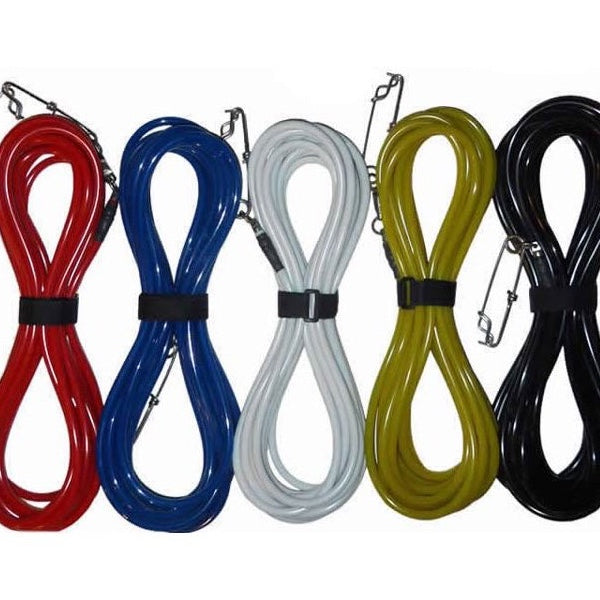
Choosing the Right Floatline For You
Choosing the Right Floatline For You
There are many factors that go into choosing the right floatline. Some of these factors are based on your ability as a diver, some on the conditions you are diving in, and others on the species you are hunting. 90% of your diving that requires a floatline can be accomplished with one floatline purchase. Even advanced divers only ever have two or three floatlines, and only buy new ones if their old ones are lost or damaged. Let’s look into the factors involved to help narrow down your search for floatline.
Diver Limitations on Floatline Choice
The biggest consideration in purchasing a floatline is a divers limitations. There is no point in buying a floatline that is 120’ if you can only dive 50’ underwater. Long floatlines can be a hassle in the water and on the boat, and that hassle becomes pointless if you are not capable of using the bulk of the floatline. That being said, you do want a floatline that is longer than your current ability to dive. There are a couple of reasons for this.
The first is you want to leave some room for you to progress as a diver. The second, and more pressing reason, is that your floatline will almost never be straight up and down in the water while you dive. You will inevitably be dragging your float behind you. As you dive down, your float will move towards you, but as you approach the limit of your floatline you will start meeting resistance from your float. The simple solution to this is to purchase a floatline that exceeds your diving ability by 10-25%.
Dive Conditions
The dive environment and conditions can limit your choices of floatline. The depth of the water is a big factor. It does not matter if you can dive down to 100’ (30m) to hunt fish if you are only in 50’ (15m) of water. As mentioned earlier, unnecessarily long floatlines can be cumbersome, or even hazardous in the water (because of entanglement risks). One way to temporarily shorten a floatline is to utilize a floatline clutch to bring your float to the right length on the floatline for your depth.
Other considerations could include the type of structure you will be diving around. Large vertical structure, like bridges or platforms, can provide great structure for fish to congregate. Unfortunately, they also provide entanglement hazards with floatlines and floats. It is important to maintain control of your float and floatline around these structures. Shorter floatlines are easier to manage, and floatline management is easier with fewer attachments, like additional floats or bungees.
Species Considerations on Types of Floatlines
General Floatline
Up to this point, we have mostly discussed considerations in the length of your floatline. The species you are targeting has the greatest impact on the material or type of floatline you should purchase. If you are looking for the right floatline for a generalist spearo, it is hard to beat the Neptonics Pressure Pro Floatline. It has a built in bungee, which helps prevent the entanglement issue that secondary bungees occasionally have. The built in bungee creates enough gradual pressure to help prevent a fish tearing out, but also limits the additional distance a fish can move to keep the fish from going into the reef.
Tough Skinned Fish
There are some species where the extra give that a bungee has can prevent you from landing the fish. Dogtooth Tuna and large Cubera Snapper are great examples. They are species you need to to prevent from diving down into the reef. These species tough skin makes the risk of tearing out of the fish from too much back-pressure less of a concern than letting them get to the reef. Cuberas will get into the reef and never come out or eventually break your equipment in the reef. Dogtooth Tuna will simply dive all of your equipment to 300 feet, getting your equipment tangled up on the reef at a depth where recovering your equipment is impossible.
This makes the strategy of landing these species to tie them to the surface and prevent them from taking your floats underwater. If you do use a bungee on these species, you want it to be small. The Neptonics Bluewater Pro is the durable and strong option helpful in landing these tough fish.
Tuna
If you are hunting tuna in thousands of feet of water you don’t want a traditional "floatline" at all. Instead, you might want to consider a Tuna Bungee. In that deep water, you're looking at a 75’ -100’ tuna bungee. Between your first and second float you can also use a smaller tuna bungee, for example to 25’ or 50’ tuna bungee. These are important because you need to create gradual pressure on the fish as your floats are submerged one by one, or else the sudden and massive amount of pressure these fish can create will destroy all of your equipment.
